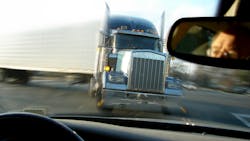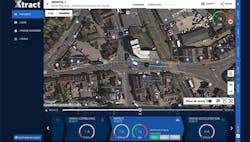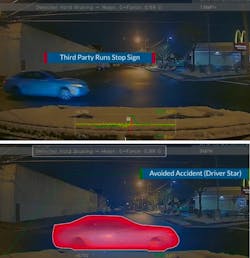In the unfortunate event of a truck-related fatality, it’s common for the driver steering the 18-wheeler, and company he or she works for, to get the blame. It’s no help to the trucking community that the photographs of the scene play up the horror element: a chunk of highway surrounded by yellow police tape and shaded red by ambulance lights, where the passenger cars are mangled messes of steel and the semi stands intact.
That trucker must have fallen asleep, been on their phone or just not be very good at their job, many seeing such images reason. While those are all possible reasons for a crash, of course, the data tells a different story.
A 2002 American Automobile Association (AAA) study using 1995-1998 data assigned driver-related factors on the part of passenger car drivers 80% of the time in fatal car-truck crashes versus 27% for commercial truck drivers.
According to a University of Michigan Transportation Research Institute study in 2007, passenger cars are solely at fault 70% of the time, while truck drivers cause the crash 16% of the time. In 10% of cases, both parties failed to act in a safe and legal manner.
The American Trucking Associations (ATA) used this study for a 2013 report, which received pushback from the Truck Safety Coalition, which called the report “a fallacious attack on victims of truck crashes” that had “no scientific basis.”
There has not been any major research into the topic since the advent of advanced driver-assistance systems, which include collision mitigation and lane departure and blind-spot warnings. This technology should likely help reduce all crashes, though it’s unknown what impact that has on assigning fault in crashes between trucks and light vehicles. The Federal Motor Carrier Safety Administration is currently mulling a new Large Truck Crash Causal Factors Study (LTCCS) to better understand the issue.
ATA President Chris Spear also noted in testimony to Congress in 2019 that truck crashes were “on the rise” and that “initiating a new large truck crash causation study would be an effective tool in understanding the increase in large truck-involved crashes.”
Whatever the findings revealed by a new LTCCS, the known data at the very least shows truckers and the fleets they drive for should not immediately be branded as the guilty party, just as any U.S. citizen should be assumed innocent until proven guilty. And in the age of telematics and dash cams, understanding what happened during a crash, and who is at fault, becomes far more clear. Specifically, the addition of sensors and cameras has allowed fleets to reconstruct crashes in real-time.
Visualizing the crash with data
A telematics company started in Dublin called Xtract uses accelerometer and GPS data to provide a visual representation of a crash almost instantly. The software, which operates through major telematics providers such as Geotab, helps fleets and their insurers get a sense of what happened and why, taking into account speed, vehicle positioning on the road, and even weather.
It’s all about discovering that “10 seconds of truth,” Xtract CEO Michael Flanagan told FleetOwner. Sometimes the truth is that the car perhaps cut off a truck or ran a red light, and other times it’s because the truck driver made a mistake. And everything is set up in the Xtract360 app with the claims handler in mind, which ultimately helps the fleet.
“From that moment of impact to the moment when the claims handler sees the reconstruction of the crash is about 60 seconds,” Flanagan said, noting previously this may have taken three weeks, and sometimes important information, such as the driver statement, could have been written with pen and paper.
In a presentation in Munich demoing Xtract’s capabilities, Flanagan showed a case where a truck was making a turn and collided with a car.
Within seconds, the insurance handler received a reconstruction that included a satellite view of the road with an icon of the truck moving south. Braking data showed the truck slowed before turning right, but not enough to avoid hitting another vehicle at a g-force of 5.6. The weather conditions indicated it was raining and at night. The algorithm immediately judged the truck 100% liable given the variables.
Next, the claims handler can access the license plate info of the third party and based on the g-force, point of impact, and make and model, know if the car is totaled or repairable. The modeling can also predict injuries to the driver.
“Having this information quickly helps [insurance handlers] make the right decisions early and means the fleet’s truck gets back on the road faster, and they get to keep their costs down,” Flanagan explained. “They also get the payout on claims that they should payout.”
For the claims handler, which in the U.S. includes AXA XL, all this is incredibly important as the longer it takes to figure out, the more costs accrue.
“Rather than having to process a sea of disjointed data, you get a clear, cohesive real-world view and are able to interpret the crash and figure out what really happened,” said insurance consultant and author Bryan Falchuk on Xtract's technology. “It brings much more in-context order to the overall claim file, which actually sounds simple, but is incredibly powerful.”
Everything is digital and organized, speeding up the claims process. Falchuk, managing partner of Insurance Evolution Partners and author of "The Future of Insurance," noted there could be 78 documents or more for one claim, from witness statements to photos, and are often organized by date, making it difficult to visualize a crash event.
The longer this takes, the harder it is to help make those affected whole again, which Falchuk said is the root of why insurance exists in the first place.
“It's there to protect people at the worst moments of their lives and help put them put the pieces back together,” he said. “That's a really important and noble cause. And I think we lose sight of that.
And presenting the data in the most honest and accurate way is the right thing to do.
“If you can recreate the event, you can do a better job at helping people,” he said.
Tim McCarthy, Xtract's EVP of business development, noted that for claims under $100,000, the data allows a trucking company involved in a crash to potentially swing the verdict to the fleet’s favor, or adjust the at-fault percentage in arbitration from 100 or 75% down to 50%, for example.
“Having a decision about the outcome of that claim quickly is a really big deal, McCarthy noted. “You don't want to be sitting out there for a year or two years, and that happens with some of the high-liability cases. Everybody lawyers up.”
With the facts of the crash right in front of them, there is less need for a court case, and possibly a jury that could render a nuclear, or multimillion-dollar, verdict, against the fleet. “No one really knows what juries will do until they do it,” McCarty said. “You want to avoid that if you can.”
Dashcams
While the data tells a story of the crash that’s hard to deny, then having the actual crash on video removes all doubt in most cases.
First off, this is key to avoiding nuclear verdicts and also incorrectly blaming the fleet’s driver. In one instance involving Atlas Trucking where a passenger car driver was left a quadriplegic, the police report faulted the truck driver, but video evidence showed that was incorrect.
Without the video, Atlas would have “fired the driver immediately, and we’d probably be facing a $40 million lawsuit that we would have lost,” Jeff Bronson, senior director of transportation at Atlas told FleetOwner.
There used to be the old chestnut of fleet reluctance to adopt dash cams due to the invasion of privacy, or Big Brother effect. But in reality, the dashcam videos are only looked at when there is a reason to, and this often vindicates the driver.
“We hear stories that range from video proving that a driver didn’t tear up Mrs. Smith’s flower beds, to cases where video shows plaintiffs backing into parked trucks,” reported Ryan Driscoll, VP of marketing at GPS Insight, which provides driver management and dashcam solutions. “One of our client’s drivers reported rear-ending another vehicle. The fleet manager thought this would mean the insurance companies would find his driver at fault. After reviewing the camera footage, they agreed that it was the other driver's fault for cutting off our client's driver and slamming on their brakes. This wouldn't be possible without video footage.”
According to Driscoll, GPS Insight's tracking and smart cameras can reduce accident claims by 70-90%. And the tactical use of edge computing allows one safety manager to monitor the dashcams of 100 drivers and reduce claims “while spending little or no additional hours managing their drivers’ behavior,” he said.
“The camera costs less than a tank of gas each month, and with the money you will save on fuel spend, it can pay for itself,” Driscoll added.
The cost of not having a claim could be far higher. Verdicts against trucking companies rose 483% year over year from 2017 to 2018, according to the American Transportation Research Institute (ATRI).
“In many of the cases that we hear, the video is all that opposing counsel needs to see to dismiss claims, so these cases don’t even get before a judge or a jury,” Driscoll said.
Along with avoiding nuclear verdicts, video helps curtail “crash-for-cash” schemes, said Driscoll, who added these grifts cost insurance carriers $20 billion annually. These costs are passed down to all policyholders. And Driscoll said businesses are often the car con artists’ mark.
He recounted one case where the video exonerated the truck driver and also proved the woman in the passenger vehicle was not thrown from her car, as she claimed. The case was dropped upon video review.
Nuclear armistice
Not all fleets face nuclear cases, but they are all at risk for a collision just by having trucks on the road. That’s the mentality fleets must take in adopting the best technology to evade predators, if Falchuk’s warnings are to be believed.
“There's a nuclear arms race in litigation,” he asserted. “There's literally investment dollars flowing into the plaintiffs’ bar to fund these cases because the return on that investment is massive.”
His solution is certainly not to throw more lawyers at the problem, but that is what’s happening.
“There isn't really much the insurance industry can do other than spending on even better lawyers,” Falchuk said. “That's not a long-term play. All we're doing is we're trading indemnity dollars for adjusting dollars and defense dollars. And that's not really the right answer.”
So what is?
“We are at a place where we now have access to technology that can change that dynamic,” he continued. “So rather than just looking at it as who has the better attorney, we can now try to use actual facts that may have helped us avoid the loss in the first place, but certainly help us deal with it if it does come.”
About the Author
John Hitch
Editor
John Hitch is the editor-in-chief of Fleet Maintenance, providing maintenance management and technicians with the the latest information on the tools and strategies to keep their fleets' commercial vehicles moving. He is based out of Cleveland, Ohio, and was previously senior editor for FleetOwner. He previously wrote about manufacturing and advanced technology for IndustryWeek and New Equipment Digest.




